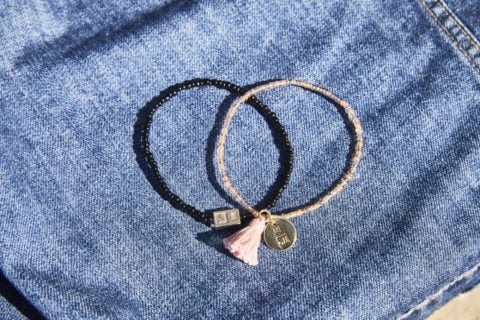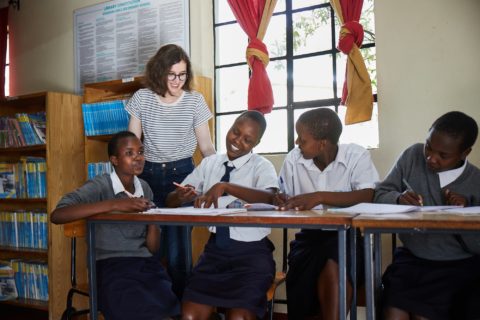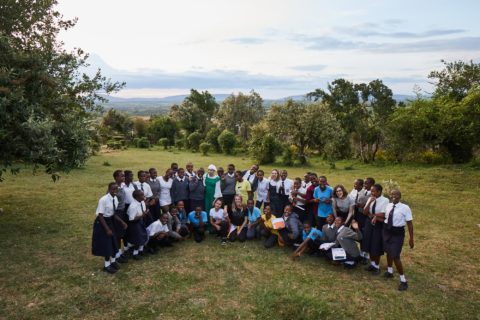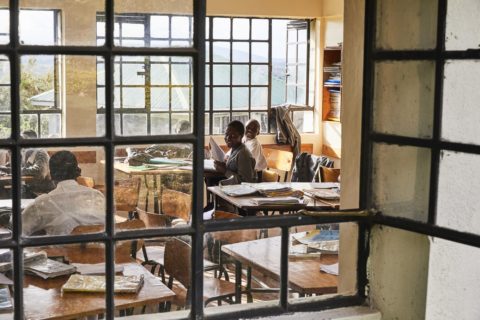This $3 Bracelet Is Helping Fund Education in Kenya
The Kisaruni All Girls Secondary School in Masaai Mara sits on a lush green campus nestled in the foothills of rural Kenya. On one of the small white buildings dotting the campus, a painted banner curls around one of the buildings spelling out Kisaruni’s mission: “We are always learning.” A stray cat roams the grounds, offering friendly meows to passers by.
I’m here as part of a special education convoy to teach some of the students a journalism workshop. Kisaruni was opened by the WE Charity in 2011 to empower young Kenyan women through education. Alongside an actor, a dancer, a singer and an activist, we’ve all been brought over by Call it Spring and Me to We to teach the tools of our unique trades to broaden the girls’ horizon and potentially spark interest in a future career.
Call it Spring has committed to building 10 classrooms in Maasai Mara over the next three years that will house over 400 students. In addition, they’re also launching a line of elegant beaded friendship bracelets — called ‘rafikis’ in Swahili –that will raise funds for purchasing school supplies to stock those classrooms. The purchase of a single $3 bracelet will provide enough school supplies for one learner. (The bracelets come in pale pink and black are available exclusively at Call it Spring stores and online.)

Some context: Secondary school education in Kenya costs money, a problem that schools like Kisaruni help mitigate by offering full scholarships to almost all their students. One Grade 10 student I spoke with, Sylvia Meikuaye, says that being offered a scholarship at Kisaruni was a chance to “change her background.” Sylvia dreams of becoming a civil and structural engineer, an oddly specific career ambition for a 16-year-old. “Being in a developing country inspires me, so I can make plans for constructing houses, buildings, roads and also bridges,” she says. “Because my parents can’t support me and my other siblings, Kisaruni is the only place that I can get a chance.”
Sylvia’s classmate, Daisy Pesian, is similarly ambitious but has set her sights on a different goal of becoming a rapper. Daisy’s heroes are the Kenyan performer Nyashinki and Cardi B. Daisy first started rapping after she saw Nyashinki on TV and began doing his material. Now she’s written over 28 original songs, which she hopes to record and make music videos for. “Before Kisaruni, I wasn’t able to talk to my classmates, not even tell them ‘good morning.’ Kisaruni has helped me improve my confidence skills. For example, I can now perform my songs in front of people.” I asked Daisy if she’d be willing to perform one of her raps, and the verse she proceeded to spit was straight-up nasty — in a good way. (Sample lyrics: “All of my haters who hate me/You don’t want me to succeed?/I want to smush your head.”)

But back to the journalism workshop. I give the students a primer on how to conduct themselves during an interview to get the best answers out of their subjects (answer: leave space for them to talk, always ask follow-up questions), then divide them into pairs so they can interview a classmate and write a short biography of their friend using what they learned from the interview. But the best part of the workshop happens during the free form q&a session where the students ask me extremely thoughtful and frank questions about my career as a working journalist. (Example: Can you be an introvert and still be a journalist? How much money do you make?)
Afterwards, we participate in a ‘recital’ where students share the skills they learned from each of the workshops. When two of my students go onstage to share their written stories, I beam with pride as they use incredible comedic timing to get the audience laughing. Frankly, it put most literary readings I’ve been to in Toronto to shame.
To witness the equal measures of seriousness and silliness these confident young women brought to the workshop was a firsthand lesson (for me!) of just how empowering education can be. With the courage and skills these girls gain from attending school, anything is possible. So go buy a bracelet. It’s literally the least you can do.









